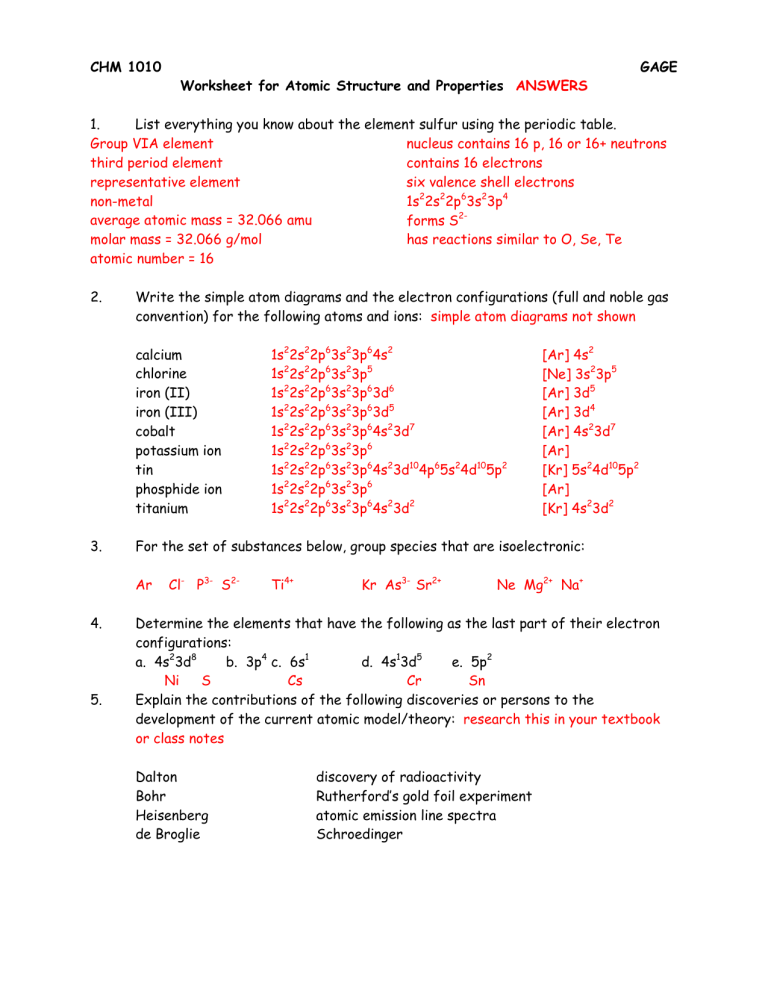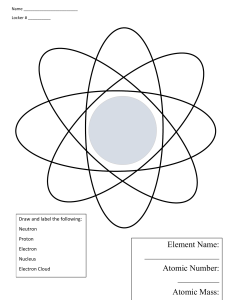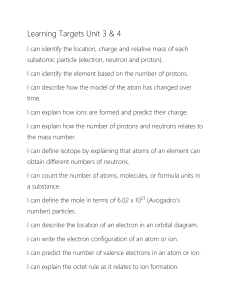
CHM 1010 GAGE Worksheet for Atomic Structure and Properties ANSWERS 1. List everything you know about the element sulfur using the periodic table. nucleus contains 16 p, 16 or 16+ neutrons Group VIA element contains 16 electrons third period element six valence shell electrons representative element 1s22s22p63s23p4 non-metal average atomic mass = 32.066 amu forms S2molar mass = 32.066 g/mol has reactions similar to O, Se, Te atomic number = 16 2. Write the simple atom diagrams and the electron configurations (full and noble gas convention) for the following atoms and ions: simple atom diagrams not shown calcium chlorine iron (II) iron (III) cobalt potassium ion tin phosphide ion titanium 3. 5. [Ar] 4s2 [Ne] 3s23p5 [Ar] 3d5 [Ar] 3d4 [Ar] 4s23d7 [Ar] [Kr] 5s24d105p2 [Ar] [Kr] 4s23d2 For the set of substances below, group species that are isoelectronic: Ar 4. 1s22s22p63s23p64s2 1s22s22p63s23p5 1s22s22p63s23p63d6 1s22s22p63s23p63d5 1s22s22p63s23p64s23d7 1s22s22p63s23p6 1s22s22p63s23p64s23d104p65s24d105p2 1s22s22p63s23p6 1s22s22p63s23p64s23d2 Cl- P3- S2- Ti4+ Kr As3- Sr2+ Ne Mg2+ Na+ Determine the elements that have the following as the last part of their electron configurations: a. 4s23d8 b. 3p4 c. 6s1 d. 4s13d5 e. 5p2 Ni S Cs Cr Sn Explain the contributions of the following discoveries or persons to the development of the current atomic model/theory: research this in your textbook or class notes Dalton Bohr Heisenberg de Broglie discovery of radioactivity Rutherford’s gold foil experiment atomic emission line spectra Schroedinger 6. Place the following sets of atoms in order from smallest to largest radius and explain why. (Don’t just say “because the trend is...”) a. Mn Ca Br As Br As Mn Ca Increasing number of protons results in increasing nuclear pull on electrons. For atoms with same number of electron shells, the higher the atomic number, the smaller the radius. b. Te S O Se O S Se Te These elements are in the same family with the same number of valence electrons but one additional electron shell per period. The larger the number of electron shells, the larger the radius. c. S F O Si F O S Si S and Si have an additional electron shell so they are larger than O and F. In each period, the atom with more protons will be smaller because of the larger nuclear force so S is smaller than Si and F is smaller O. 7. Place the following atoms in order from largest to smallest first ionization potential (energy) and explain the ranking: a. Sr Ba Be Mg Be Mg Sr Ba The closer an electron is to the nucleus, the harder it will be to remove it since force decreases inversely with the square of the distance from the force. b. Br I F Cl F Cl Br I The closer an electron is to the nucleus, the harder it will be to remove it since force decreases inversely with the square of the distance from the force. 8. How does the size of potassium compare to a potassium ion. Why? Answer the same question for sulfur and the sulfide ion. Electron affinity is the energy change that occurs when an electron is added to a neutral atom. This is the opposite of ionization energy which is the energy require to remove an electron from a neutral atom. They both involve the transfer of an electron to or from a neutral atom. Atoms with the highest electron affinity are those that most benefit from the addition of an electron, such as F. The more negative the affinity value, the greater the amount of energy released. 9. How is electron affinity the same and different from ionization energy? Which elements have the highest electron affinity? Why? A potassium atom is larger than the potassium ion because in forming the ion there is a loss of the outer shell so the radius becomes the boundary of the smaller inner shell. When sulfur forms an ion electrons are added to the outer shell. These additional electrons help shield the influence of the nucleus and so the outer electron shell becomes larger. Therefore the sulfide anion is larger than the atomic sulfur.






